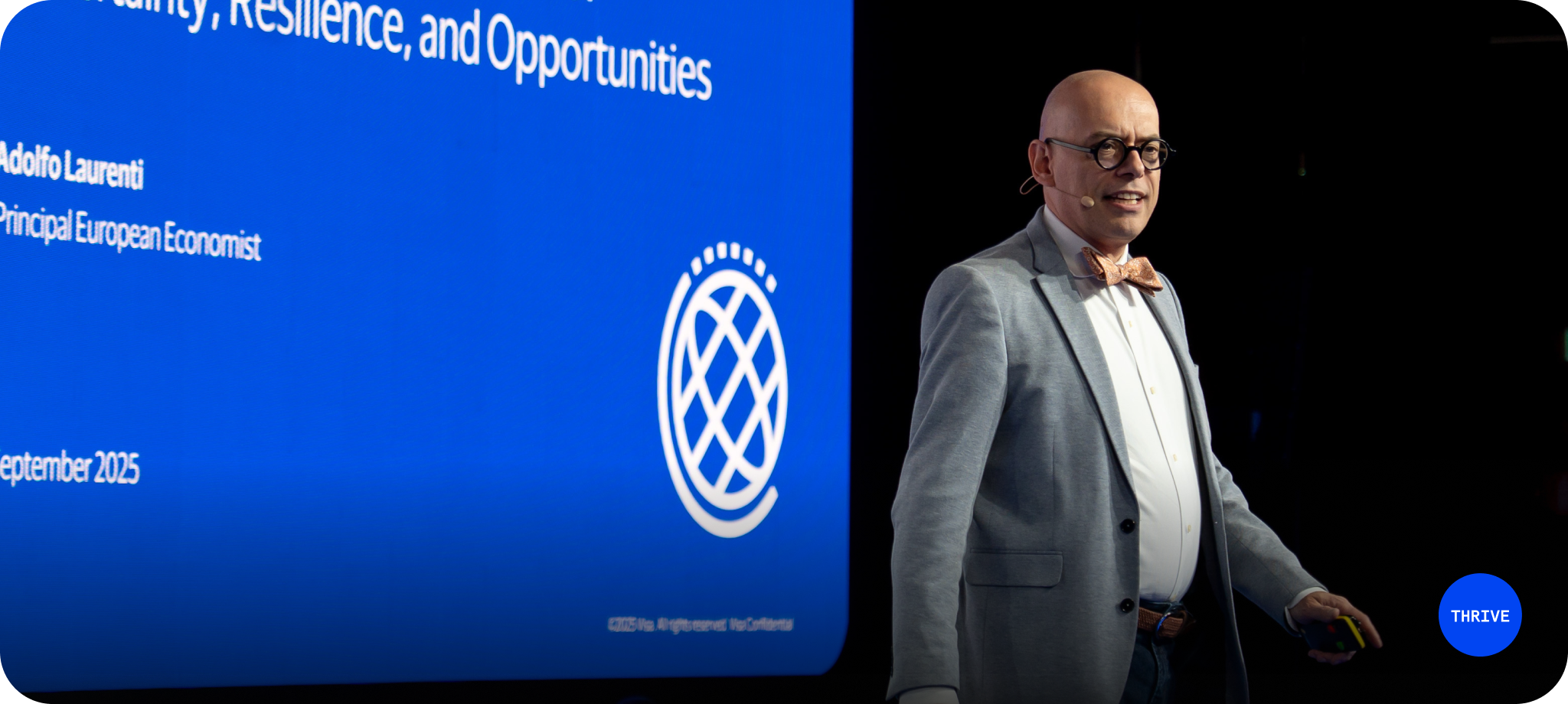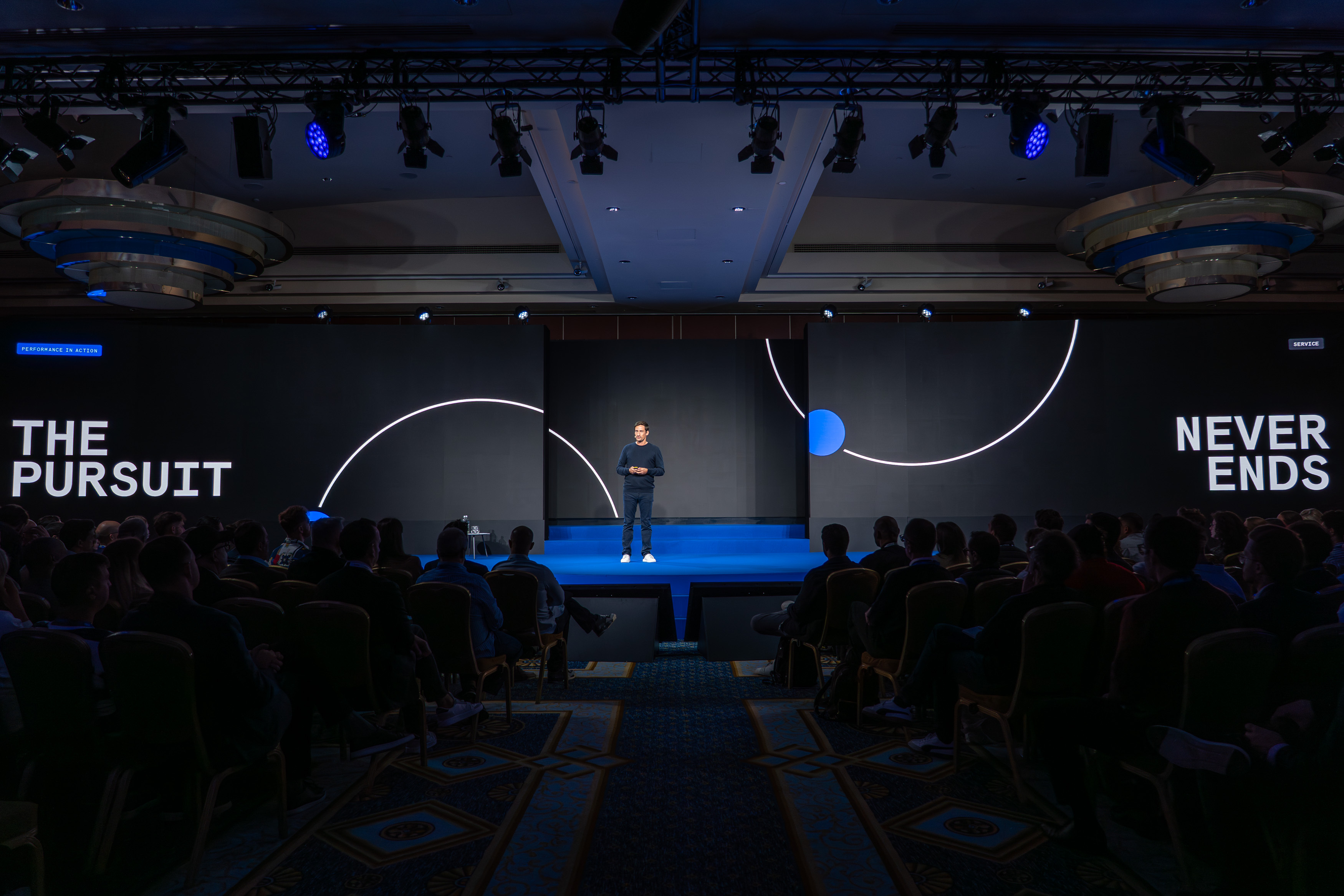This year’s Thrive event in Venice brought together leaders from across the payments ecosystem to examine the future of digital commerce. Over three days, discussions centered on innovation, resilience, and partnership in pursuit of performance.
From AI-driven optimization and agentic commerce to fraud prevention and cross-border expansion, the sessions reflected an industry evolving at pace, and a community determined to work together to shape what comes next.
Payments leaders across travel, technology, and digital goods and services, explored how smarter, more adaptable partnerships are redefining the way money moves.
Here are the key takeaways from Thrive 2025.
AI-powered payment performance
Conversations around AI have shifted towards performance, and the compounding value it delivers over time.
Across sessions, speakers shared how AI now drives measurable business impact, improving acceptance rates, recovering lost revenue, and powering faster, smarter decisions across the payments stack.
One example shared was Checkout.com’s Intelligent Acceptance. It applies machine learning to every transaction, running billions of permutations in milliseconds to find the best path to approval.
The results speak for themselves:
- Up to 3% higher acceptance rates
- Over 10 million transactions optimized daily
- $20 billion projected revenue recovered by the end of 2025
It’s a model that improves with every transaction.
As Daniel Linder, Senior Director of Product at Checkout.com, shared:
“Performance is about balancing acceptance, fraud, and cost to deliver sustainable results. What we’re seeing is that our models are getting smarter every day, thanks to the combination of advanced AI and more data. The more we ingest, the better the decisions.”
One long-term vision shared at Thrive was the rise of self-healing systems – infrastructure that can detect and resolve issues before they impact performance. Speakers explored the shift from monolithic AI models to more unified systems built with explainability in mind, and designed to be both reliable and safe.
Partnering for performance

Guillaume Pousaz, Founder & CEO at Checkout.com, shared:
“We are a merchant-first company, we believe in the power of partnerships, and it’s very important that every optimization and improvement flows back to customers. This is a core belief of ours.”
At Checkout.com, partnerships are built on trust. These relationships are grounded in shared ambition and designed to deliver mutual value, ensuring every optimization and improvement benefits the merchant.
The philosophy is reflected in what Guillaume described as the “power of the network” – made up of three essential components:
- Community (the partnerships that are forged)
- Technology (the data, pipes, and systems that connect it all)
- Expertise (the instinct and insight of payment performance specialists)
It’s this network effect that drives performance, and as the network scales, the benefits grow for everyone.
Partnerships thrive on co-creation and a shared commitment to solving problems that matter. Working closely enables space to experiment, share insight, and deliver outcomes with impact across the ecosystem.
For high-growth merchants, a strategic payments partner is essential. One that aligns with business ambitions and views payments as a driver of long-term performance. In the absence of a dedicated Chief Payments Officer internally, a strong partnership can provide the necessary guidance and expertise.
Melissa Pottenger, Vice President, Payment Operations at Reach, shared:
“If you don’t recognize how payments as a function in your business is so pivotal to success and unlocking value, ensuring consumer loyalty and looking at that as one comprehensive unit in your business, you’re leaving something on the table. If you don’t have a Chief Payments Officer in your business, you have a great partner in Checkout.com. Lean into the relationship, seek consultative guidance, and learn.”

Collaboration to shape what’s next in AI and agentic commerce
No single player can shape the future alone. It requires collective effort across merchants, PSPs, schemes, tech giants, and LLM providers to shape it in a way that’s scalable and safe for everyone.
AI is already transforming commerce. Agentic commerce presents new challenges around data, security, accountability, and user experience. The recurring theme? Co-creation over fragmentation. Siloed solutions won’t scale. Collaboration now means defining standards, assigning liability, and designing protocols that protect everyone – consumers and businesses alike.
Security, trust, and resilience
Fraud attempts are rising each year, driven by deepfakes, synthetic IDs, and AI-assisted attacks. But false positives – blocking good customers and losing revenue – are just as big of an issue.
Johan Lindstrom, Senior Vice President, Global Acceptance at Mastercard, said:
“The first element to establish that trust and security is to have transparency through the system. It’s a shared responsibility – between schemes, PSPs, issuers, and merchants – to build systems that protect all parties, without creating unnecessary friction.”
While the risks around AI and agentic commerce are real, there was also a note of optimism.

As Gary McMahon, Group Product Manager at Sainsbury’s Digital, Tech and Data pointed out:
“We’ve been here before as an industry. If you think back to contactless, a lot of those problems existed back then, and now it’s part of everyday life. This has the opportunity to do the same.”
Trust in AI-powered payments hinges on more than fighting fraud, it’s also about protecting good customers and the industry sharing accountability.
.png)
Balancing act at checkout
Fighting fraud isn’t about saying no more often. It’s about saying yes, but safely. The challenge is to balance protection with conversion.
It’s not about eliminating all risk, but maximizing revenue by ensuring good customers aren’t blocked. That means managing the tension between acceptance and security, and doing it in a way that earns trust.
.png)
“We’ve moved in the past five years from seeing friction as something to avoid, to recognizing it as a sign of safety,” said Sophia Furber, Fintech Research Analyst at S&P Global. “Today’s consumers are deeply aware of fraud, and if they haven’t experienced it themselves, they know someone who has. They welcome the right guardrails.”
Consumers are increasingly comfortable with stronger security. Research from S&P Global, shared at Thrive, found that 76% of shoppers are happy to complete extra verification steps. Experts called this “good friction” – the kind that builds confidence.
But removing all risk means removing opportunity.
Julia Körffer-Höhne, Head of Payments DACH & France at Netflix, put it clearly:
“If you drill the funnel down so much that you have no fraud, you’ll also have no business. It’s always a balancing act – letting in enough good customers to drive growth, while keeping the bad actors out.”

Meron Colbeci, Chief Product Officer at Checkout.com, noted the agentic era raises a new kind of question about fraud:
“We’re entering a world where the cardholder is by definition not the person making the purchase, so how do we know it’s not a fraudulent agent?”
That’s the next challenge. Meeting it will require better onboarding and stronger credentialing like biometric passkeys.
Built for resilience
Resilience was a key theme, especially in high-value, complex journeys like travel and digital marketplaces. When transactions involve large sums and lengthy, complex customer journeys, performance at checkout becomes critical.
Karen Bolda, Chief Product & Technology Officer at Expedia Group, put it simply:
”The moment of payment is when performance and resilience have to come together. You can’t have a customer go through the entire journey only to end in failure at the point of transaction.”

That risk is exactly why resilience is non-negotiable. For businesses in travel, it’s the first thing they look for in a payments partner.
Payments are often invisible to the end user, but they underpin every purchase. If this core infrastructure fails, nothing else works as it should. That’s why resilience requires treating payments as a critical part of your infrastructure.
Global and cross-border payments
Expanding into new markets is about relevance. Businesses with international ambitions need payment infrastructure that meets local expectations, aligns with regulations, and delivers performance at scale.
Expanding market by market
Speakers from all industries agreed that localization is what drives performance. Local rails and regulatory alignment are the foundations of true scale.
Checkout.com’s recent expansion reflects this approach:
- Japan: local payment rails to improve domestic performance
- Canada: domestic routing to lower cross-border fees, especially for U.S. merchants
In both markets, all the core capabilities needed were delivered – from local payment rails to domestic routing – achieving market-best performance levels and reducing cross-border fees where it matters most.
Checkout.com achieved a major milestone in the US, where the application to become a Merchant Acquirer Limited Purpose Bank was accepted. Approval is expected to come by the end of 2025, and the initial operationalization for its top priority merchants at the end of 2026. This enables full-stack acquiring in the US, giving merchants the same end-to-end control and performance already available across Europe and MENA.

Localization drives conversion
Throughout the event, localization was described as the fastest way to lift conversion. Regional nuance, from preferred payment methods to local regulations, can make or break the checkout experience.
A travel technology provider shared that partners often require local payment methods, such as regional digital wallets, regardless of volume. In markets like Europe, where preferences vary by country, merchants offering the right local methods are the ones winning market share.
Scaling the infrastructure
Expansion only works if the infrastructure keeps up. One global travel platform saw rapid growth in Asia, bringing new challenges, from navigating different payment rails to ensuring visibility across time zones.
Checkout.com’s Flow helps solve this. It embeds flexible, region-aware infrastructure directly into merchant workflows, enabling faster localization and higher conversion, without the need for rebuilds. Some merchants are already seeing up to 7% higher acceptance rates as a result.
Flow adoption is accelerating, with 65% of Checkout.com's new merchants choosing it as their integration method. And for returning customers, performance gets an extra boost with Flow Remember Me – Flow’s opt-in feature that securely stores customers’ payment details to accelerate repeat checkouts, making checkout times up to 70% faster. At this scale, every basis point gained translates into millions in recovered revenue.
The future of payments: Agentic commerce, stablecoins, and unified platforms
The rise of agentic interactions
Agentic systems change the dynamics of commerce. Instead of advising consumers, they act for them by searching, comparing, and purchasing in the background.
Early use cases are practical, but their implications reach much further. Several merchants are already experimenting by:
- Introducing AI shopping agents for discovery
- Testing agentic ordering via chat, voice, and connected devices
- Developing AI assistants to manage recurring purchases automatically
These shifts are driven by a new generation of digital natives who expect technology to anticipate their needs. As adoption grows, so does the need for trust. In agentic commerce, retailers must take the lead in shaping the customer experience. That means proactively feeding high-quality, accurate information into the systems doing the buying – rather than waiting to be scraped. Done well, this approach benefits everyone involved.
As Adolfo Laurenti, Principal European Economist at Visa, explained:
“I find it fascinating that today, 70% of the global population has internet access. And this goes hand-in-hand with another key trend shaping the future. As of 2025, more than half of the global population belongs to Gen Z and Gen Alpha. This means over half the world are digital natives.”

Designing for an agent-first world
Looking ahead, consumers will expect experiences tailored to their preferences, habits, and financial behavior. Merchants will need infrastructure flexible enough for agent-to-agent commerce, where payments, loyalty systems, and product data are machine-readable and interoperable. But with that shift comes a new challenge: maintaining emotional connection in a world of automated interactions. Loyalty still matters, but how it’s accessed and delivered needs to evolve.
This challenge is amplified because agents, capable of instant comparison, risk commoditizing products and raising the bar for what a successful loyalty program must deliver. For purchases requiring emotion or contextual nuance, such as travel, maintaining trust in the automated experience will be crucial. Despite the automation ahead, speakers agreed emotional connection will still drive loyalty.
Stablecoins
Stablecoins are being positioned by some as the future of digital payments, particularly with moves like the GENIUS Act in the US, which has given new impetus to the space. Regulation was seen as both a necessary enabler and a potential constraint. The key is finding the right balance: enabling innovation without compromising safety or clarity.
Industry leaders pointed out that stablecoins’ most compelling business case today lies in their speed, cost efficiency, and ability to open new markets – especially for merchants operating across borders or in emerging markets.
Several real-world examples were highlighted, including cross-border remittances, B2B marketplace payments, supplier payouts, and treasury management. There’s clear appeal in the promise of instant, low-cost, borderless payments. But significant challenges remain. Questions around liquidity and trust will be critical to solve – as will ensuring stablecoins integrate effectively with the existing financial system.
Ultimately, adoption will accelerate when integration becomes smooth and governance more transparent. Merchants want predictability and compliance as much as they want efficiency.

The power of unified platforms
Another defining theme was the performance advantage of unifying acquiring and issuing within a single system. A global travel enterprise shared how this approach provided greater control and improved approval rates within one financial account.
Mariano Albera, Chief Technology Officer at Checkout.com shared:
“When you combine acquiring, issuing, and the Checkout Business Account, you get a fantastic financial infrastructure for enterprises. It means you can access your funds instantly, and put them to use whenever you need.”
This level of connectedness is the backbone of next-generation payments innovation – powering everything from agentic commerce and embedded finance to real-time treasury flows.
By unifying acquiring, issuing, and the Checkout.com Business Account, enterprises gain a cohesive financial infrastructure. This setup helps combat what one speaker described as “dead money in the system,” by enabling both inflows and outflows through a single currency account – revealing new levels of flexibility and control.
For another global travel company, this setup has delivered significant operational gains. Relying on immediate post-purchase ticketing, they need to lock in dynamic airline pricing the moment a customer pays. With a single platform and highly optimized flow, they’ve shaved precious time off their processing, helping them act faster and capture value.
The pursuit of performance never ends
As Thrive 2025 demonstrated, the ecosystem is entering an era of intelligent acceleration. Guillaume underlined that the biggest opportunity lies in delivering high performance, enterprise-grade payments, reliably, everywhere in the world.
That pursuit includes expanding the Checkout.com Business Account – a bold step into the B2B digital banking space, with the ambition to challenge established financial giants.
Guillaume also reinforced what partnership means in practice for Checkout.com: “Make us uncomfortable. Keep pushing us.” That tension, he explained, is what drives meaningful progress.















.png)
